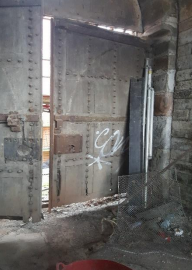Dorothea Restorations complete conservation of new gaol gates at Wapping Wharf
 As part of the regeneration of Bristol’s Wapping Wharf, Dorothea Restoration has now completed the conservation of the new gaol gates which stand at the southern end of the site. The Grade II listed Gatehouse is to form a new pedestrian path to lead into this interesting and vibrant site of new homes and businesses.
As part of the regeneration of Bristol’s Wapping Wharf, Dorothea Restoration has now completed the conservation of the new gaol gates which stand at the southern end of the site. The Grade II listed Gatehouse is to form a new pedestrian path to lead into this interesting and vibrant site of new homes and businesses.
Here is a snapshot of some of its history, built between 1816 & 1820 to replace the medieval Newgate prison north of the Castle. It was designed to resemble a castle fortification with an imposing gatehouse and mock portcullis. The gatehouse doubled as a stage for holding public hangings, with a trap-door built into it, through which the condemned were dropped.
The first execution took place on Friday 13 April, 1821, John Horwood was hanged for the murder of Eliza Balsom. Horwood had thrown a stone at Eliza, injuring her head. Sometime later a Dr. Richard Smith operated for a depressed skull fracture. This intervention caused an abscess which proved fatal. When questioned by police, Dr. Smith gave Horwood’s name and testified against him for Eliza’s murder. Horwood’s body was given to Dr. Smith for dissection and study. He used the boy’s skin to bind the case notes. Dr. Smith’s ‘Skin Book’ is on display at the MShed Museum grizzly. The last hanging was on Friday 20 April 1849, the servant girl Sarah Thomas was hanged for murdering her elderly employer. A huge crowd gathered to watch Sarah’s hanging. The event was so moving the Prison Governor fainted and the spectators were deeply disturbed. Sarah’s was the last execution in Bristol and the last teenage girl in Britain.
The New Gaol was attacked by rioters in 1831 who breached the iron gates, freed the 170 inmates and set light to the buildings. After the riots, it was rebuilt but had closed by 1883 and the site bought by the Great Western Railway Company. Most of the building had been destroyed in 1898, leaving the surviving gatehouse and parts of the southern perimeter wall which have been given Grade II listed status.
The Client agreed that the gates should be conserved and not restore retaining the historic value and existing character which was visible during first inspection. The project aim was to retain as much of the original fabric, provide strength and stability to the gates whilst reducing the rate of decay and making them safe.
Dorothea Restoration proceeded by carefully removing individual straps and replacing the missing shanks where required, at the same time all rust jacking and debris could be removed and treated with an inhibitor. Additional fixing straps were installed to provide a secure fixing where the timber has been damaged by rust jacking.
Missing wrought iron sheets were replaced and weathered to match the existing as far as practicable. The security grills have been manually cleaned and treated with a rust inhibitor to seal any porosity which is common in cast iron objects. The cast iron hinges were freed after several weeks of treatment ensuring that the lead pockets within the stone walls remain undisturbed and secure.
Finally, the gates were opened reducing their exposure to the elements whilst providing an exceptional entrance for residents and visitors to the Spike Island development.

For more from this company visit their website www.dorothearestorations.com















